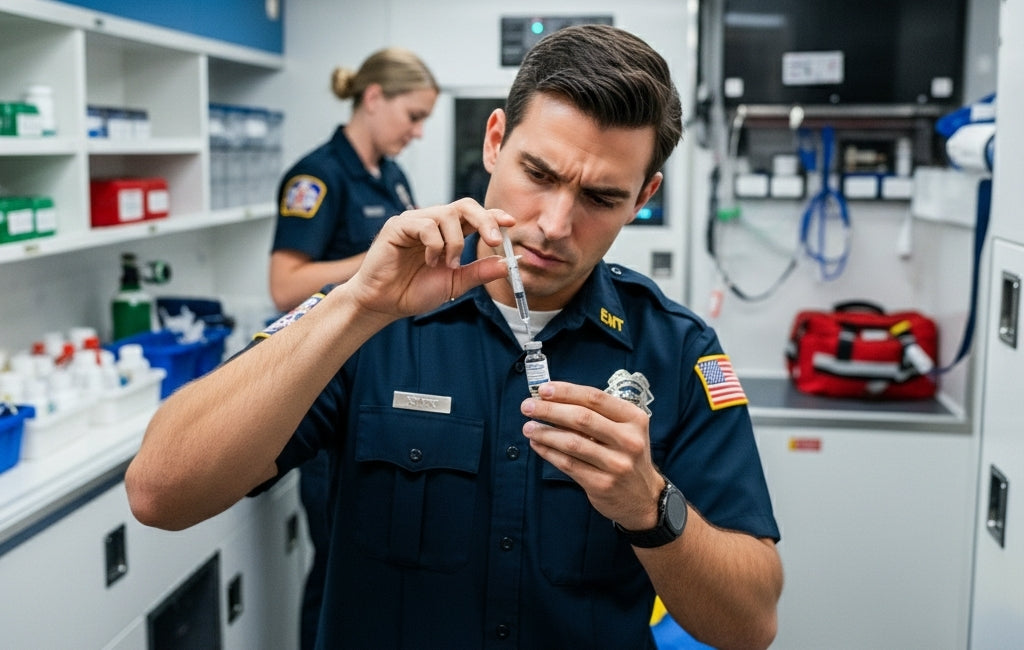One tiny decimal, one missed conversion, one rushed step. These small errors are the ones that haunt otherwise well-prepared NREMT candidates. The NREMT cognitive exam tests your ability to apply safe, practical medicine, and medication math is a regular place where students lose points. The good news is these mistakes are avoidable. With a handful of clear habits, the right formulas, and targeted practice you can cut errors dramatically, protect patient safety, and improve your score on test day.
This post walks through the most common medication calculation pitfalls on the NREMT cognitive exam, shows you reliable ways to calculate quickly and accurately, explains special considerations for pediatric, weight-based dosing, and gives exam-day tactics you can use immediately.
Why Medication Math Matters on the NREMT Exam
Medication questions test three things at once: numeracy, unit fluency, and clinical judgment.
On the exam you’ll need to:
·Convert between units (mg ↔ g, lb ↔ kg, mcg ↔ mg),
·Apply the universal dose formula, and
·Recognize when an answer is unsafe or outside the EMT/BLS scope.
Medication errors are common in clinical practice and in testing alike, often driven by decimal mistakes, unit mix-ups, or rushed work. Understanding the pattern of these mistakes helps you prevent them.
The Five Most Common Calculation Mistakes (and How to Stop Them)
1. Decimal Point Errors (The Most Dangerous)
Misplacing a decimal or using a trailing zero can cause tenfold dosing errors. As an exam habit, always write a leading zero before decimals less than one (write 0.5 mg, never .5 mg) and never use trailing zeros (write 4 mg, not 4.0 mg). These are standard safety recommendations to prevent catastrophic errors.
Quick Habit: On practice problems, write the leading zero every time and cross out any trailing zeros you see in stems. Make this muscle memory.
2. Unit Conversion Mistakes
Students frequently mix milligrams, micrograms, grams, or confuse mL with cc. For pediatric weight-based dosing the most common slip is failing to convert pounds to kilograms correctly.
A reliable rule: kg = pounds ÷ 2.2 (or multiply pounds by 0.45 as a faster approximate). Practice that conversion until it’s automatic.
Quick Habit: Estimate the answer first. If your math gives an absurd dose (e.g., 50 mL for a 10 kg child when 2.5 mL makes sense), stop and recalculate.
3. Misusing the Dose Formula
The universal formula is simple and repeatable:
(Desired dose ÷ Available concentration) × Volume = mL to administer
Put another way: Desired/Have × Volume.
If the units don’t match (mg vs mcg, or mg vs mg/mL), you’ll get the wrong answer. Always check units before you compute.
Example: Order 250 mg. You have a vial labeled 500 mg / 5 mL. Calculation: (250 ÷ 500) × 5 = 2.5 mL.
Practice this until it’s automatic so you don’t mix up numerator and denominator under pressure.
4. Pediatric and Weight-Based Dosing Errors
Pediatric dosing multiplies the chance of math mistakes because you must estimate weight (if no scale) and convert units.
Many EMS systems use weight-based references or tapes, and protocols instruct you to use estimated kilograms when necessary. Know your local quick conversion and use the universal formula after converting weight to kilograms. Regional protocols commonly specify using estimated kg values for pediatric dosing; treat those as authoritative in your practice and exam prep.
Quick Habit: Memorize a few key conversion anchor points (eg, 50 lb ≈ 23 kg, 44 lb ≈ 20 kg) so you can eyeball a reasonable kg while confirming with the division method.
5. Rushing, Distractions, and Skip-Checks
Distractions and rushing cause simple arithmetic or transcription errors. Always double-enter numbers into your calculator if allowed and, where possible, recheck critical med calculations.
If a colleague can independently verify a high-risk calculation in the field, do it. On the exam, recheck the math and units twice before finalizing an answer.
Research on medication errors highlights that organizational, human, and environmental factors (like interruptions and unclear labeling) drive many mistakes; we can reduce those by standardizing how we write and calculate during study and on test day.
Tools You Should Practice With
·On-Screen Calculator: The NREMT exam provides an on-screen calculator during the exam; practice with similar basic calculators so keystrokes feel natural. The NREMT handbook confirms an on-screen calculator is available and that the test is CAT. Practice pacing accordingly.
·Conversion Cheat Sheets for Study: While you can’t bring a cheat sheet to the test, it’s useful in practice sessions to build familiarity.
·Weight-Based Dosing Charts: At How To NREMT, we provide pediatric dosing guides; study them to recognize standard concentrations and common volumes. Regional protocols explicitly recommend estimating kg and using local dosing tables when available.
Exam-Day Habits That Reduce Errors

Image Caption: On exam day, practice clear habits like estimating first and double-checking your work to avoid small mistakes that can cost you big points.
1. Read the Stem Twice: Confirm the patient weight, route, and concentration before calculating.
2. Match Units First: Don’t compute until units line up. Convert mg ↔ mcg or lb ↔ kg as needed.
3. Estimate Before Calculating: Ask yourself if the answer should be under 1 mL, a few mL, or tens of mL. If your math gives something wildly different, recheck.
4. Write Clearly: Use 0.5 instead of .5, don’t write 4.0, and always include units (mg, mL) in your working notes. This prevents misreading your own work. NCCMERP and industry guidance recommend leading zeros and discourage trailing zeros in dosing.
5. Reenter Calculations: If you use the on-screen calculator, type the calculation twice and compare results.
Special Note on High-Risk Meds and Double Checks
Certain medications carry higher consequences for error (e.g., epinephrine, opioids, sedatives). For these, your study habit should include an automatic second check: estimate, calculate, then re-estimate. In clinical practice, a colleague often verifies high-risk doses; on the exam you must verify by re-calculation and unit check.
How To NREMT Helps You Avoid Tiny Errors
At How To NREMT, we teach calculation habits that become second nature: unit checks before math, consistent use of the Desired/Have×Volume formula, automatic kg conversions, and the “estimate first” mindset that catches outliers. Our practice materials mirror the NREMT cognitive exam, include timed medication drills, pediatric weight-based scenarios, and med-math walkthroughs so you learn the math and the clinical context.
If you want a structured plan that keeps you from losing easy points, join us. Our full-access membership includes targeted med-math practice and real exam simulations, and our private coaching can walk through high-risk scenarios step-by-step.
Take the first step today.

